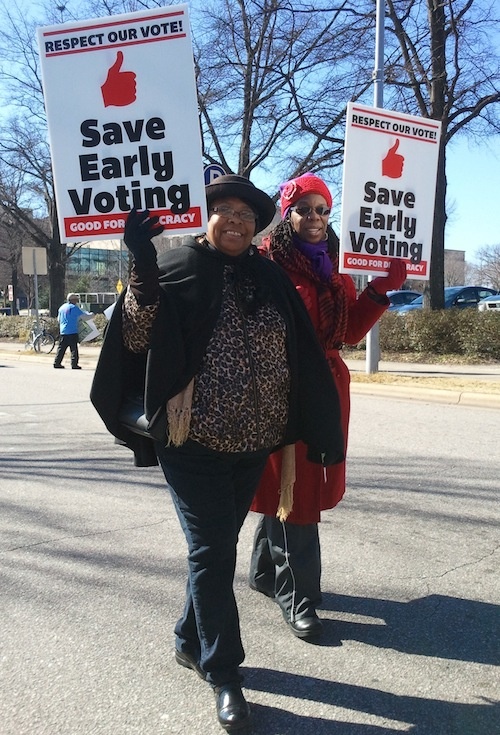Black voter suppression in North Carolina: statewide numbers vs. local reality

Hearings began today in an action by civil rights groups to block North Carolina's restrictive new voting law from being enforced in the November election while its constitutionality is being considered, with an overflow crowd showing up at a Winston-Salem courtroom to witness the proceedings.
The Voter Information Verification Act (VIVA) has provisions shortening the early voting period, eliminating same-day registration, and banning out-of-precinct voting. It also requires poll workers to ask voters whether they have a photo ID, which they will have to show in order to cast a ballot beginning in 2016.
One of the arguments made by the law's defenders is that since 44,500 more black voters cast ballots in the state's 2014 primary than in the previous midterm primary, any claims the law results in voter suppression or discrimination are bogus.
But a new analysis of voter data tells a more complicated story.
The elections watchdog group Democracy North Carolina analyzed county-by-county voting patterns and concluded that "focusing on the statewide total distorts large differences experienced by voters depending on where they live."
Among the findings:
* While more African Americans voted in North Carolina's 2014 midterm primary than in the 2010 primary, black turnout decreased in eight of the 15 counties where African Americans make up over 39 percent of the registered voters. The decrease was both in the percent of registered black voters who voted and in the actual number of votes cast.
* Black turnout as a percent of registered voters who cast ballots fell in 32 of the state's 100 counties from the 2010 to the 2014 primary, including in the 16 counties where African Americans make up over 29 percent of registered voters.
* Two-thirds of the increased number of votes cast by African Americans statewide in this year's primary came from just seven counties where there were either hot races or more opportunities for early voting than in 2010.
The biggest increase in African-American voter turnout was in Mecklenburg County, with 8,272 more black votes cast this year than in the 2010 primary. Voters there were making picks in a hotly contested Democratic congressional primary as well as Democratic primary races for sheriff and county commission. In addition, the number of early voting sites jumped from just one in the 2010 primary to 13 in this year's primary -- the largest expansion in the state.
The second-biggest increase in black turnout was in Guilford County, where voters also weighed in on the same Democratic congressional primary and other high-profile races. That county also offered expanded early voting opportunities.
Democracy North Carolina cautions that using statewide vote totals -- and even county totals -- obscures discrimination experienced by individual voters. It cites examples including a Pitt County woman who was wrongly asked for a photo ID and many voters losing access to the most convenient polling site. But the more localized numbers "help point to the reality on the ground," the group observes.
For more details on Democracy North Carolina's findings, as well as a link to the county-by-county data file, click here.
Tags
Sue Sturgis
Sue is the former editorial director of Facing South and the Institute for Southern Studies.
